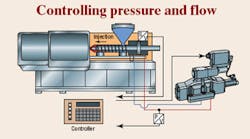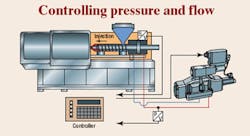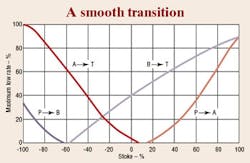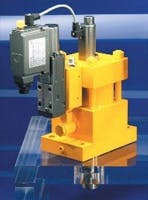This Parison servoactuator incorporates an integral zero-lapped proportional valve with LVDT feedback of spool position and LVDT for feedback of cylinder stroke.
Electromechanical drives have been designed into injection molding machines in favor of hydraulics for years — beginning with small machines and working into medium-size ones. And as the technology advances, ever larger electromechanical machines are expected to continue infiltrating applications formerly dominated by hydraulics. However, digital electrohydraulic technology is not stagnant. In addition to their incredible power, performance, and reliability, electrohydraulic drives are becoming more efficient, easier to service and troubleshoot, and easier to integrate into factory automation control networks.
For example, variable displacement axial-piston pumps with closed-loop digital controls for flow and pressure regulation have allowed hydraulic drives to regain lost ground in many small- and medium-size plastic injection molding machines. Benefits for the machine include:
- high dynamic response,
- software that allows customized operating parameters to optimize performance,
- real-time selection of different pressure and flow sets to maximize efficiency and production,
- energy saving and power limitation functions, and
- system simplification by reducing the number and complexity of proportional controls.
The injection process
Injection molding operations demand high speed motion and tight pressure control. As shown in Figure 1, an electronic control sends a command to a proportional valve that controls flow and pressure to an injection cylinder. The valve initiates an injection by controlling flow into the right side of the cylinder. Flow controls speed of the cylinder's piston, which, in turn, controls flow of molten plastic into a die.
A linear displacement transducer differentiates changes in piston position with respect to time, creating a velocity signal that is routed to the machine control. Simultaneously, a pressure transducer monitors fluid pressure in the hydraulic line feeding the cylinder.
As plastic is injected into the die, load applied to the piston increases, which, in turn, increases hydraulic fluid pressure. Control software detects when a predetermined pressure is achieved through the pressure transducer. When this occurs, the control signals the valve to transition from a speed-control mode into a pressure-control mode. The valve then continues controlling flow to right side of the cylinder to maintain the preprogrammed pressure — even if the target pressure or the load changes.
A digital proportional valve with spools tailored to injection requirements makes the critical transition from speed control to pressure control smooth and precise, without allowing any sudden changes in pressure, as shown in Figure 2. An integral P/Q digital controller coupled with a remote pressure transducer performs the closed-loop control of pressure and flow during holding and counter pressure phases of injection. In commanding the proportional valve, the P/Q controller ensures a repeatable and independent transition.
Parison control
Another application where digital electrohydraulics has been gaining ground is that of Parison servoactuators. The Parison control is a well-known processused in plastic blow-molding machines toachieve the optimal wall thickness distribution of the continuous extruded profiles.
It is mainly used to obtain hollow items as plastic bottles, which need to be thicker where the cap screws on than they do in their side walls. Wall thickness can be controlled by regulating the amount of molten plastic flowing into the blow-molding chamber. This is done by controlling stroke of a Parison cylinder that opens and closes a gate valve. This digital servoactuator is composed of:
- a custom servocylinder equipped with low friction seals and integral LVDT position transducer,
- a high-response proportional valve with zero lapped spool and LVDT position transducer, and
- integral digital electronics with double closed-loop control of pilot valve regulation and cylinder rod position. An RS232 serial communication interface permits tuning electronic control parameters via software customized for the application.
This information was provided by Fabio Balzarini, of Atos Spa, Sesto Calende, Italy. For more information, visit www.atos.com or e-mail [email protected]




